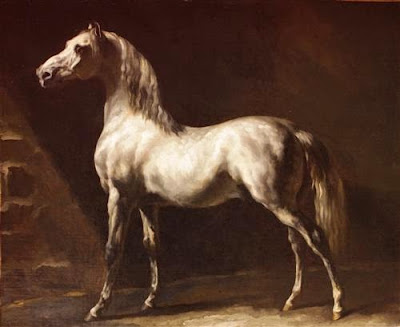A Horse is a Horse — Unevolved, of Course
The evolution of the horse is touted as one of the best examples of Darwinian evolution. You'll see the story in textbooks, on the Web, television documentaries, and other places. Unfortunately for evolutionists, their claim is more along the lines of false advertising. Genome studies have been hostile to the tale, creationists have dismantled equine evolution — and things just get worse from there.
If you've ever spent time around good horses, you know that they're graceful, powerful, and what they're designed to do, they do well. People determined to believe that there's no creator find similarities of creatures in the fossil record and imagine evolutionary lineages — even when different critters are in the same strata. The report of a possible ancestor for horses and their kinds in India and how they migrated (plus ignoring inconvenient facts) kind of makes me wonder if they've been munching on peyote buttons.
 |
| "Study of a Dapple Grey" / Theodore Gericault, 1824 |
Despite the ubiquitous presence of the “horse series” in textbooks, the origin of horses is still debated among evolutionists. Where, how, and in what order non-ruminating hoofed mammals (aka perissodactyla—like the horse, tapir and rhinoceros) evolved “is one of the great conundrums of mammalian evolution,” write the authors of a recent study reporting they found a missing link in the evolutionary story. Accordingly, the Los Angeles Times, like other news services, in November reported “Rhino horse, a ‘missing link,’ could solve 55-million-year-old mystery.” Analogous to the “sudden” appearance of diverse animals in the Cambrian explosion, perissodactyls and some other mammalian groups are mysteries, the evolutionary authors write, because they “appeared abruptly at the beginning of the Eocene across the Holarctic continents [North America, northern Eurasia, and North Africa], with little indication of their source.” The new Indian fossil, Cambaytherium, has traits similar to those in several other hoofed mammals. From the study, it is clear that the authors’ determination to view Cambaytherium as a transitional form shedding light on the horse series springs from their imaginative evolutionary worldview. Like other extinct mammals that “suddenly” appear in the fossil record, Cambaytherium is no mystery but a descendant of the kind of animals God—the Common Designer of all—created about 6,000 years ago, without evolution.To follow the trail to the rest of the article, click on "Horse Ancestor Said to Have Evolved in India".